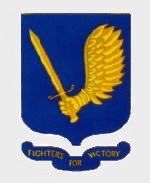Hobby Master HA1707 USAAF Bell P-39Q Airacobra Fighter - Captain Clarence E. "Bud" Anderson, "Old Crow", 363rd Fighter Squadron, 357th Fighter Group, Tonopah, California, 1943 (1:72 Scale)
"The best fighter pilot I ever saw."
- General Chuck Yeager, commenting on the flying skills of his fellow airman, Captain Clarence E. "Bud" Anderson
 The P-39 was one of America's first-line pursuit planes in December 1941. It made its initial flight in April 1939 at Wright Field and by the time of the Pearl Harbor attack, nearly 600 had been built. Its unique engine location behind the cockpit caused some pilot concern, but this proved to be no more of a hazard in a crash landing than with an engine located forward of the cockpit. However, the P-39's spin characteristics could be quite a problem if recovery techniques were ignored.
The P-39 was one of America's first-line pursuit planes in December 1941. It made its initial flight in April 1939 at Wright Field and by the time of the Pearl Harbor attack, nearly 600 had been built. Its unique engine location behind the cockpit caused some pilot concern, but this proved to be no more of a hazard in a crash landing than with an engine located forward of the cockpit. However, the P-39's spin characteristics could be quite a problem if recovery techniques were ignored.
The Airacobra saw combat throughout the world, particularly in the Southwest Pacific, Mediterranean and Russian theaters. Because its engine was not equipped with a supercharger, the P-39 performed best below 17,000 feet altitude, and it often was used at lower altitudes for such missions as ground strafing. When P-39 production ended in August 1944, Bell had built 9,584 Airacobras, of which 4,773 had been allotted to the Soviet Union. Russian pilots, in particular, liked the cannon-armed P-39 for its ground attack capability. Other P-39s served with French and British forces.
This particular 1:72 scale replica of a P-39Q Airacobra fighter was piloted by famed ace Clarence "Bud" Anderson, attached to the 363rd Fighter Squadron, 357th Fighter Group, then training at Tonopah, California, during 1943.
Sold Out!
Dimensions:
Wingspan: 5-3/4-inches
Length: 5-inches
Release Date: January 2009
 Historical Account: "Kobry" - Clarence E. "Bud" Anderson is a retired officer in the United States Air Force and a "triple ace" in World War II.
Historical Account: "Kobry" - Clarence E. "Bud" Anderson is a retired officer in the United States Air Force and a "triple ace" in World War II.
Anderson was born in Oakland, California, and raised on a farm near Newcastle, California. In January 1942, he enlisted in the United States Army as an aviation cadet and received his wings and commission as a second lieutenant in September 1942.
Anderson flew two tours of combat against the Luftwaffe in Europe while with the 363rd Fighter Squadron of the 357th Fighter Group, based at RAF Leiston, England, and was the group's 3rd leading ace with 16 1/4 aerial victories. His P-51, nicknamed Old Crow, carried him safely through 116 missions without being hit by fire from enemy aircraft and without Anderson ever having to turn back for any reason. He returned to the United States in February 1945 holding the rank of captain.
With over thirty years of military service, Anderson was a test pilot at Wright Field (where he also served as Chief of Fighter Operations) and Edwards Air Force Base (where he was Chief of Flight Test Operations and Deputy Director of Flight Test), served two tours at the The Pentagon and commanded three fighter organizations. From June to December 1970 he commanded the 355th Tactical Fighter Wing, an F-105 unit, during its final months of service in the Vietnam War, and retired in March 1972. He was decorated twenty-five times for his service to the United States.
After his retirement from active duty as a colonel, he became the manager of the McDonnell Aircraft Company's Flight Test Facility at Edwards AFB, serving there until 1984.
During his career, he flew over 100 types of aircraft, and logged over 7,000 hours. Anderson is possibly best known for a close friendship with Chuck Yeager from World War II, where both served in the 357th Fighter Group, to the present. Yeager once called him "The best fighter pilot I ever saw."









